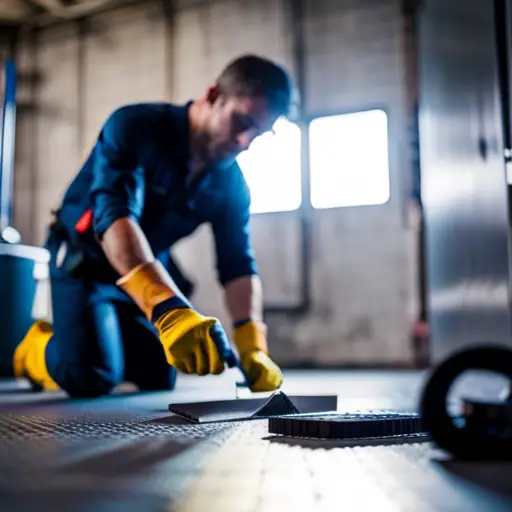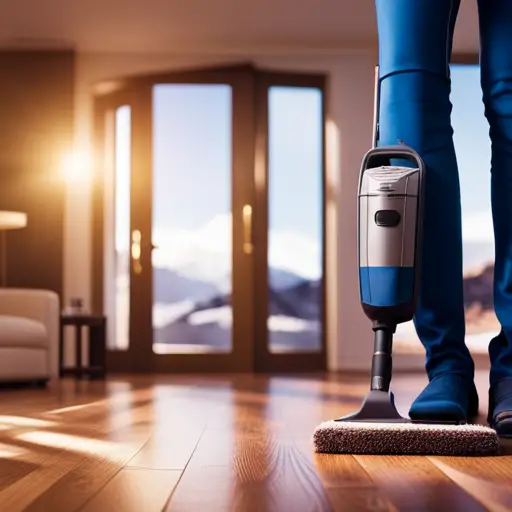Installing Heated Floors: A Guide

Time-honored wisdom dictates that a warm foundation is the key to a comfortable home.
This guide to installing heated floors provides a comprehensive overview of the different systems available, along with essential planning and preparation tips.
From the necessary tools and materials to the step-by-step installation process, this article equips readers with the knowledge to create a cozy and efficient heated floor system.
Additionally, maintenance and troubleshooting advice ensures long-term functionality and comfort.
Types of Heated Floor Systems
When considering installing heated floors, it is essential to be aware of the various types of heated floor systems available. The two primary options are electric and hydronic systems.
Electric underfloor heating options involve the installation of electric coils beneath the floor, which produce heat when an electric current passes through them. On the other hand, hydronic systems use a network of plastic tubing to circulate hot water beneath the floor, providing warmth.
In terms of cost comparison, electric systems are generally more affordable to install than hydronic systems. However, hydronic systems are often more energy efficient and can lead to lower long-term operational costs, especially in larger spaces. Hydronic systems are also compatible with various heat sources, including solar, making them an environmentally friendly option.
Planning and Preparation
Before initiating the installation of heated floors, meticulous planning and thorough preparation are crucial for a successful and efficient process. Proper planning ensures that the installation process runs smoothly and that the heated floors function effectively. Here are key aspects to consider during the planning and preparation phase:
-
Preparing the Subfloor: It is essential to ensure that the subfloor is clean, level, and free from any debris before installing heated floors. Any unevenness in the subfloor can lead to hot or cold spots in the flooring, impacting the overall efficiency of the system. Additionally, addressing any existing moisture issues in the subfloor is vital to prevent damage to the heating elements.
-
Electrical Requirements: Understanding the electrical requirements for the heated floors is crucial. This includes determining the voltage and electrical load capacity needed for the system. It is important to consult with a qualified electrician to ensure that the electrical infrastructure meets the specific requirements of the heated flooring system.
-
Insulation and Heat Retention: Assessing the insulation and heat retention properties of the room is important for optimizing the performance of heated floors. Adequate insulation helps in minimizing heat loss, ensuring that the heated floors operate efficiently while reducing energy consumption.
Careful consideration of these factors during the planning and preparation stage is fundamental to the successful installation of heated floors.
Tools and Materials Needed
To proceed with the installation of heated floors, meticulous planning and thorough preparation of the subfloor, electrical requirements, and insulation and heat retention are essential. Now, addressing the tools and materials needed for the installation is crucial to ensuring a successful and efficient process.
| Tools | Materials |
|---|---|
| Measuring tape | Heating cables/mat |
| Spirit level | Insulation boards/film |
| Notched trowel | Thermostat and sensor |
| Tile cutter | Floor primer |
| Electric drill | Self-leveling compound |
| Cable monitor | Floor covering (tiles, wood, etc.) |
Estimating the cost of tools and materials is vital for budgeting. Additionally, considering energy efficiency and installation techniques can impact long-term savings and effectiveness. When choosing floor covering options, factors such as conductivity and comfort should be taken into account. Transitioning into the subsequent section about the ‘step-by-step installation process,’ understanding the tools and materials needed lays a solid foundation for a successful heated floor installation.
Step-by-Step Installation Process
The installation process for heated floors begins with thorough preparation of the subfloor, ensuring it is clean, level, and properly insulated. Once the subfloor is ready, the installation of underfloor heating can commence.
Here’s a step-by-step guide for installing heated floors:
-
Selecting the Heating System: Decide between electric and water-based underfloor heating systems. Electric systems are easier and cheaper to install, making them suitable for renovations. On the other hand, water-based systems are more commonly used in new constructions and provide a more cost-effective solution for larger areas.
-
Laying the Heating Elements: Lay the electric heating mats or water pipes evenly across the subfloor, ensuring proper spacing to achieve uniform heating. Secure the elements firmly in place, following the manufacturer’s guidelines and local building codes.
-
Connecting the Controls: Install the thermostat and connect it to the heating elements. Ensure the system is wired correctly and test it thoroughly before proceeding with the floor covering installation.
Maintenance and Troubleshooting
Regular maintenance of heated floors is essential to ensure optimal performance and troubleshoot any issues that may arise. To maintain heated floors, it is important to regularly inspect the system for any signs of damage or malfunctions. This includes checking the thermostat settings, ensuring proper insulation, and examining the floor surface for any damage or wear. Additionally, it is crucial to keep the floor clean and free from any obstructions that may hinder the heat distribution.
Long-term care for heated floors involves periodic professional inspections to assess the overall functionality of the system. These inspections can help identify any potential issues before they escalate, ensuring the longevity of the heated flooring system. Furthermore, following manufacturer’s guidelines for maintenance and operation is key to preventing avoidable problems.
When troubleshooting heated floors, it is important to first check the power supply and thermostat settings. If the floor is not heating properly, it may be necessary to inspect the heating elements for any damage or irregularities. It is also advisable to verify that the floor sensors are functioning correctly. If issues persist, seeking assistance from a qualified technician is recommended to diagnose and resolve any complex problems.
Frequently Asked Questions
Can Heated Floors Be Installed in All Types of Flooring, Including Hardwood and Carpet?
Heated floors can be installed in various types of flooring, including hardwood and carpet. Hardwood is generally compatible with radiant heating systems, and there are specific methods for installing heated floors beneath carpeted surfaces for effective heat distribution.
Are There Any Health or Safety Concerns Associated With Heated Floors, Such as Electromagnetic Fields or Overheating?
Health and safety concerns associated with heated floors include potential exposure to electromagnetic fields and risks of overheating. It is important to consider these factors when installing heated floors to ensure the well-being of occupants.
How Much Will Installing Heated Floors Affect My Energy Bills?
The installation of heated floors can impact energy bills, but the energy efficiency and cost comparison should be considered. While initial costs may be higher, the long-term energy savings and comfort benefits are significant.
Can Heated Floors Be Used in Bathrooms and Other Areas With High Moisture Levels?
Heated floors can be used in bathrooms and high-moisture areas with proper moisture resistance. However, it’s crucial to consider maintenance requirements for these systems in such environments to ensure their longevity and optimal performance.
Are There Any Special Considerations for Installing Heated Floors in Older Homes With Existing Heating Systems?
When installing heated floors in older homes with existing heating systems, it’s crucial to assess insulation needs and ensure compatibility with the HVAC system. Proper insulation and integration with the current heating setup are essential for optimal performance.
Conclusion
In conclusion, installing heated floors requires careful planning, the right tools and materials, and a step-by-step installation process.
Maintenance and troubleshooting are essential to ensure the system continues to work efficiently.
Just like a well-built house, a properly installed heated floor system can provide comfort and warmth for years to come, making it a worthwhile investment for any homeowner.

Rubin Everest, a seasoned expert in the world of flooring, brings a wealth of knowledge and passion to the surface. As the mind behind ebbow.com, Rubin is dedicated to sharing insights on the latest trends, innovative solutions, and expert advice in the realm of flooring. Whether you’re seeking practical tips for installation or design inspiration, Rubin Everest is your go-to source for all things flooring-related, making your journey to the perfect floor an informed and enjoyable experience.





